Make a Safe Splash with Your Dog this Summer–
Water Safety Tips
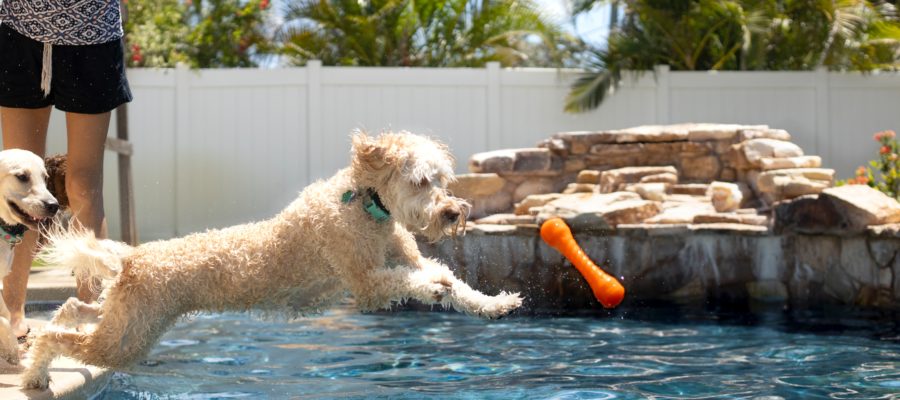
By Arden Moore – The Pet Health and Safety Coach™
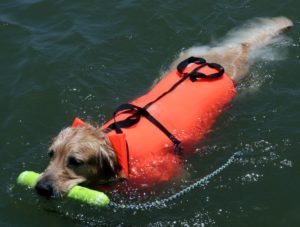 Now that warm weather has arrived, there are many options for your dog to swim from backyard pools to lakes, rivers, and oceans. Swimming is a great form of exercise for dogs especially when it is blazing hot outside and the pavement is too hot on their paws. Water’s natural buoyancy is far kinder on canine joints than long walks on concrete sidewalks or leaping to snag a Frisbee in the backyard. In water, dogs can benefit from purposeful movement to keep their joints lubricated and their muscles toned. Swimming is also a great way to help dogs who need more exercise than their owners.
Now that warm weather has arrived, there are many options for your dog to swim from backyard pools to lakes, rivers, and oceans. Swimming is a great form of exercise for dogs especially when it is blazing hot outside and the pavement is too hot on their paws. Water’s natural buoyancy is far kinder on canine joints than long walks on concrete sidewalks or leaping to snag a Frisbee in the backyard. In water, dogs can benefit from purposeful movement to keep their joints lubricated and their muscles toned. Swimming is also a great way to help dogs who need more exercise than their owners.
When it comes to our dogs and swimming, it’s vital to bust a common canine myth: dogs are not born with the swimming gene. The first time Olympic gold medalist Michael Phelps entered a pool, he didn’t set any records. He first had to learn how to swim. Like Phelps, your dog needs to learn how to swim – and most importantly, feel safe in the water.
DOES YOUR DOG LOVE WATER OR LAND?
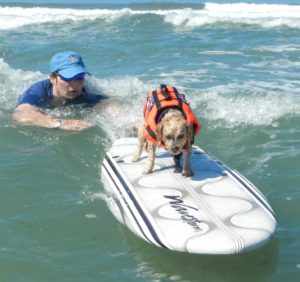 Many dogs really dig splashing and swimming. My late, great dogs, Chipper and Cleo never turned down an opportunity to do the dog paddle when I lived in Oceanside, California. In fact, they were members of the original So Cal Surf Dogs and enjoyed ‘hanging 20’ on foam surfboards at the dog-friendly beaches in San Diego County.
Many dogs really dig splashing and swimming. My late, great dogs, Chipper and Cleo never turned down an opportunity to do the dog paddle when I lived in Oceanside, California. In fact, they were members of the original So Cal Surf Dogs and enjoyed ‘hanging 20’ on foam surfboards at the dog-friendly beaches in San Diego County.
But other dogs, like my sweet, terrier-mix Kona, prefer to be land lovers. Kona will reluctantly wade ankle-deep inside the giant bone-shaped pool I view as a cool oasis now that we live in Dallas, Texas where the temperatures can surpass 100 degrees. Kona prefers scurrying inside the house to enjoy the air conditioning.
This brings me to my first tip: know your dog. If he digs in his paws at the shoreline or quickly jumps out of the kiddie pool or trembles as you bring him near lake, he is doing his doggone best to let you know that swimming is not tops on his list of favorite activities. Forcing water activities can trigger panic and fear in these dogs.
However, some puppies and dogs just need to take it slow and build their confidence into becoming fans of water activities. Some breeds face challenges in learning the dog paddle include such as those with short legs and long backs like Corgis and Dachshunds, or barrel-chested dogs like Bulldogs and dogs with short snouts (Pugs).
9 TIPS TO KEEP WATER PLAY SAFE
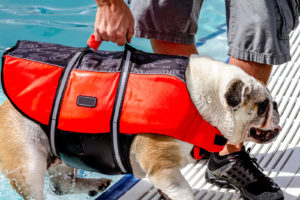 I’m a big advocate of safe water play for dogs. Set your dog up for success by heeding these tips:
I’m a big advocate of safe water play for dogs. Set your dog up for success by heeding these tips:
- Select safe water spots. Never let your dog swim in small ponds constructed to drain water from housing developments. They contain a lot of lawn chemicals. Another doggy water no-no: ponds at golf courses because of the parasites swimming in abundance in those pods. Avoid lakes with algae and steer clear of water with fast currents.
- Book a veterinary appointment. Make sure your dog receives vaccines to protect against parasites and giardia.
- Gear up. Fit your dog in a canine life jacket that feature easy-to-grab handles before any water play time. Some top picks include those made by Outward Hound or ZippyPaws. Or consider personal flotation devices like the Hedz UP Pets Watercollar, a donut-shaped floatation that fits through a collar and keeps your dog’s head above water to minimize the risk of him drowning. Consider attaching a long floating line to your dog’s D-ring on the life jacket so you can easily rein him in.
- Protect your pooch from the sun’s rays. Before swim time, dab on the right sunscreen in the right places. The sunscreen needs to be waterproof, quick drying and non-greasy. Select veterinarian-approved sunscreens and apply on the abdomen, legs and tips of the nose and ears. Never use sunscreens on your dog that made for people because they may contain ingredients not safe for use on dogs
- Start slowly in the swallow end of a pool or along the shoreline. Do not toss your dog into the pool because they may trigger a lifelong fear of water. Do offer praise and treats when he gets his legs wet on his own. Be patient and encouraging.
- Teach your dog how to safely enter and exit a pool at the shallow end. In training, whistle and shake a treat container at the pool steps to train your dog to always go the steps to exit. Otherwise, your dog may desperately paddle the pool walls, become exhausted and panic in not knowing how to safely exit.
- Be your dog’s lifeguard on duty. Never let your dog in your pool without your supervision and make sure that your pool has a doggy-proof gate to block his access when you’re not around.
- End water play before your dog becomes overtired. Rushing in and out of the water to fetch balls under the searing sun can quickly fatigue your dog. Limit intense water play to 10 minutes or so. Take breaks and provide your dog with fresh water in a shaded area.
- Take a pet first aid class. Learn how to perform canine CPR and rescue breathing and what to do if your dog is drowning. Knowing what to do – and what not to do – in a pet emergency when minutes count is truly the best way to be your dog’s best health ally.
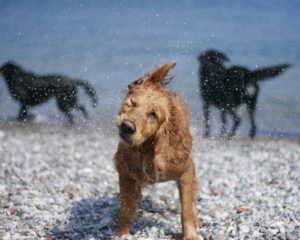 After your happy dog does that full body shake, it’s time to treat him to a healthy bath and rinse to rid his coat and skin of any pool chemicals, salt water from the ocean or dirty water from lakes and rivers. It’s also a good idea to keep dog’s ears clean and dry – especially if your dog is prone to ear infections. The ZYMOX line of veterinarian-approved products can help. The line includes a Shampoo, Leave-On Conditioner and Ear Cleanser to help keep your dog’s skin, coat and ears healthy so they can continue to enjoy swimming.
After your happy dog does that full body shake, it’s time to treat him to a healthy bath and rinse to rid his coat and skin of any pool chemicals, salt water from the ocean or dirty water from lakes and rivers. It’s also a good idea to keep dog’s ears clean and dry – especially if your dog is prone to ear infections. The ZYMOX line of veterinarian-approved products can help. The line includes a Shampoo, Leave-On Conditioner and Ear Cleanser to help keep your dog’s skin, coat and ears healthy so they can continue to enjoy swimming.
 Arden Moore wears many collars in the pet world. She is a best-selling author, master certified pet first aid/CPR instructor, pet behavior consultant, host of the Oh Behave Show on Pet Life Radio and happy pet parent to a Furry Brady Bunch in Dallas. Learn more at www.ardenmoore.com.
Arden Moore wears many collars in the pet world. She is a best-selling author, master certified pet first aid/CPR instructor, pet behavior consultant, host of the Oh Behave Show on Pet Life Radio and happy pet parent to a Furry Brady Bunch in Dallas. Learn more at www.ardenmoore.com.

